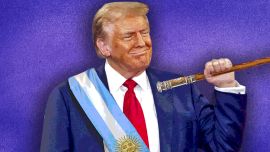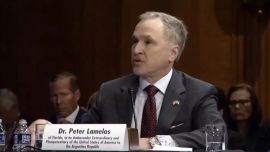Nisman, la víctima 86 is the name of a local documentary on the mysterious death of special AMIA prosecutor Natalio Alberto Nisman (1963-2015) exactly 10 years ago today, although his harshest critics might find him more akin to the bumbling Maxwell Smart character Secret Agent 86. As it happens, 86 was the official death toll from the terrorist bomb destruction of the AMIA Jewish community centre on July 18, 1994, for some months afterwards until it was found that one vile human being had seen the confusion as a golden opportunity for a new life (and wife) in Paraguay – the total fatalities were then given as 85 for two decades until exactly 10 years ago today.
The opinions in today’s column will not include any verdict on whether Nisman’s death was suicide or homicide amid all the judicial back and forth of the last decade. Countless people are absolutely convinced one way or the other but this columnist sees too many holes in both theories – questions like the bullet in the head following a route totally atypical of suicides versus the extreme difficulty in seeing how anybody except Nisman could have killed Nisman. Perhaps the best argument for murder is not the recent report by prosecutors going with the flow but the late Carlos Escudé bringing up the remarkably similar case of the Iranian dissident (or double agent?) Ahmad Rezai, found dead in a Dubai hotel in late 2011 with every appearance of suicide and every suspicion of murder – this would suggest that the Iranian intelligence services had perfected techniques for making murder look like suicide, even if Escudé was something of a devil’s advocate against the generally accepted theory of Iran masterminding the AMIA atrocity as well as a scathing critic of Nisman. But on this page at least the jury is staying out.
For all too many advocates of the murder hypothesis, there is only one possible culprit – Cristina Fernández de Kirchner, who a decade ago was starting the last of her eight years in the presidency. Nisman died the weekend before the Monday he was due to appear in Congress to substantiate his denunciation that CFK and various of her officials were conspiring to cover up the alleged Iranian connection in the AMIA bombing via the 2013 Memorandum of Understanding with Iran (a denunciation he was having acute problems in substantiating, according to some insisting on suicide, although in that case why so abruptly cut short his Spanish holiday with his elder daughter Iara to make it?).
Within that context, those arguing that Fernández de Kirchner had him killed in order to silence him feel that they are putting two and two together to make four, but might it not also make five? The obvious often does happen, much to the chagrin of subtle analysts and obscure conspiracy theorists, but is this not a little too obvious – how could Kirchnerism possibly hope to dodge massive suspicion in an election year? If indeed it was murder, this columnist is more inclined to suspect rogue intelligence agents within that murky underworld (then carrying the acronym of SIDE, which President Javier Milei’s government insisted on reviving in last July’s overhaul) – while keeping an open mind on Iranian participation in the light of the Ahmad Rezai precedent. And if indeed rogue intelligence, impossible to pinpoint the motivation which could range from payback against Cristina Fernández de Kirchner to some incredibly petty infighting within the service, deeply involved in the AMIA investigation from the start.
Today’s 10th anniversary of Nisman’s death was always going to be memorable but there can be no doubt of the intense interest of the ardently pro-Israeli Milei Presidency in highlighting it yet further – both the remarkable timing of the Federal Prosecutor's Office 56-page report, published just eight days before today’s 10th anniversary, and confirmation that the government had declassified documents from Argentina’s intelligence services related to the case and forwarded them to the courts in response to Federal Prosecutor Eduardo Taiano’s mid-December request for release of the sealed files, including those housed with the Army and police intelligence services.
"Federal prosecutor Natalio Alberto Nisman was the victim of homicide and his death was motivated by his work in the UFI-AMIA [unit created by Néstor Kirchner in 2004] and, specifically, by his actions related to the Memorandum of Understanding with the Republic of Iran," is the central conclusion of that report so perhaps we should be taking a closer look at that memorandum, for which Fernández de Kirchner and others are due to stand trial in a cover-up case later this year following last month’s Supreme Court ruling (which overturned her 2021 acquittal ruled on the grounds that the policies of an elected government cannot be placed on trial, no matter how good or bad they might be, a criterion with which this columnist agrees).
This latest report points to evidence that during CFK’s second presidential term there was a geopolitical rapprochement with Iran within the context of a global anti-Western realignment, which provoked divisions within Argentina’s intelligence community (divisions feeding suspicions that Nisman’s death could have been the work of rogue or dissident sectors rather than responding to orders from on top).
Nisman’s own suspicions of the motives behind the controversial memorandum brokered by Fernández de Kirchner’s late foreign minister Héctor Timerman in Ethiopia in order to cover up alleged Iranian involvement in the bombing centred on the desire to boost trade between the two countries but this columnist believes that Nisman was off-target here.
Whenever Tehran terrorism is suspected, the key does not lie in “cherchez la femme” nor in “follow the money” but “nose out the nukes.” When the Israeli Embassy here was blown to smithereens on Saint Patrick’s Day, 1992, the most widely circulated explanation here was that Iran was punishing Carlos Menem for sending two frigates to the 1990-1991 Gulf War. But why on earth should Tehran be angry over joining action against Saddam Hussein with the recent memory of around a million of their citizens perishing in the brutal 1981-1988 war between Iraq and Iran? The payback is far likelier to have stemmed from Menem rescinding contracts to supply nuclear technology to Iran in the spirit of his “carnal relations” with the United States, an explanation which would extend to the destruction of AMIA.
Even if Cristina Fernández de Kirchner's enemies often accuse her of being the ultimate evil manipulative genius, the memorandum could also have been sheer naivety, a guileless trust in the Islamic Republic’s willingness to co-operate. In any case the treaty never entered into force (nor was ever likely to) but Nisman did die. Ten years later Argentine society is still owed an explanation of a bafflingly mysterious death.























Comments